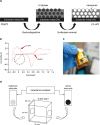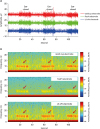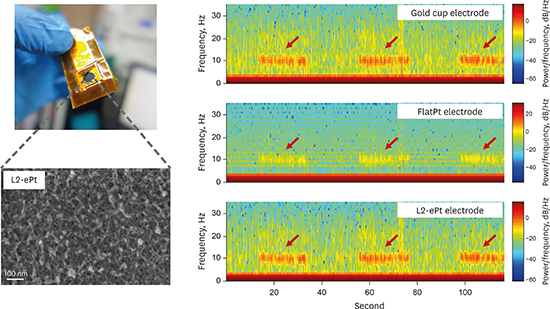1. Uhlhaas PJ, Singer W. Neural synchrony in brain disorders: relevance for cognitive dysfunctions and pathophysiology. Neuron. 2006; 52(1):155–168.

2. Brown RE, Basheer R, McKenna JT, Strecker RE, McCarley RW. Control of sleep and wakefulness. Physiol Rev. 2012; 92(3):1087–1187.

3. Noachtar S, Rémi J. The role of EEG in epilepsy: a critical review. Epilepsy Behav. 2009; 15(1):22–33.

4. Williams RL, Agnew HW, Webb WB. Sleep patterns in young adults: an EEG study. Electroencephalogr Clin Neurophysiol. 1964; 17(4):376–381.

5. Zhang XS, Roy RJ, Jensen EW. EEG complexity as a measure of depth of anesthesia for patients. IEEE Trans Biomed Eng. 2001; 48(12):1424–1433.

6. Mihajlović V, Grundlehner B, Vullers R, Penders J. Wearable, wireless EEG solutions in daily life applications: what are we missing? IEEE J Biomed Health Inform. 2015; 19(1):6–21.
7. Min BK, Marzelli MJ, Yoo SS. Neuroimaging-based approaches in the brain-computer interface. Trends Biotechnol. 2010; 28(11):552–560.

8. Lopes da Silva F. EEG and MEG: relevance to neuroscience. Neuron. 2013; 80(5):1112–1128.

9. Lee JH, Lee SM, Byeon HJ, Hong JS, Park KS, Lee SH. CNT/PDMS-based canal-typed ear electrodes for inconspicuous EEG recording. J Neural Eng. 2014; 11(4):046014.
10. Kappenman ES, Luck SJ. The effects of electrode impedance on data quality and statistical significance in ERP recordings. Psychophysiology. 2010; 47(5):888–904.

11. Looney D, Kidmose P, Park C, Ungstrup M, Rank ML, Rosenkranz K, et al. The in-the-ear recording concept: user-centered and wearable brain monitoring. IEEE Pulse. 2012; 3(6):32–42.

12. Ha S, Kim C, Chi YM, Akinin A, Maier C, Ueno A, et al. integrated circuits and electrode interfaces for noninvasive physiological monitoring. IEEE Trans Biomed Eng. 2014; 61(5):1522–1537.
13. McAdams ET, Jossinet J, Lackermeier A, Risacher F. Factors affecting electrode-gel-skin interface impedance in electrical impedance tomography. Med Biol Eng Comput. 1996; 34(6):397–408.

14. Gruetzmann A, Hansen S, Müller J. Novel dry electrodes for ECG monitoring. Physiol Meas. 2007; 28(11):1375–1390.

15. Griss P, Enoksson P, Tolvanen-Laakso HK, Merilainen P, Ollmar S, Stemme G. Micromachined electrodes for biopotential measurements. J Microelectromech Syst. 2001; 10(1):10–16.

16. Chi YM, Jung TP, Cauwenberghs G. Dry-contact and noncontact biopotential electrodes: methodological review. IEEE Rev Biomed Eng. 2010; 3:106–119.

17. Sami M, Sami P, Katja M, Mika S, Tapani AP, Tuula TP, et al. Improving electrochemical performance of flexible thin film electrodes with micropillar array structures. Meas Sci Technol. 2012; 23(12):125701.
18. Park S, Song YJ, Han JH, Boo H, Chung TD. Structural and electrochemical features of 3D nanoporous platinum electrodes. Electrochim Acta. 2010; 55(6):2029–2035.

19. Park S, Lee SY, Boo H, Kim HM, Kim KB, Kim HC, et al. Three-dimensional interstitial nanovoid of nanoparticulate Pt film electroplated from reverse micelle solution. Chem Mater. 2007; 19(14):3373–3375.

20. Park S, Song YJ, Boo H, Chung TD. Nanoporous Pt microelectrode for neural stimulation and recording: in vitro characterization. J Phys Chem C. 2010; 114(19):8721–8726.

21. Duffy FH 4th, Surwillo WW. Clinical Electroencephalography and Topographic Brain Mapping: Technology and Practice. 1st ed. New York, NY: Springer-Verlag;1989.
22. Electrode Impedance Meter F-EZM5. West Warwick, RI: Grass Instrument Co.;1982.
23. Park S, Kim HC, Chung TD. Electrochemical analysis based on nanoporous structures. Analyst (Lond). 2012; 137(17):3891–3903.

24. Fonseca C, Silva Cunha JP, Martins RE, Ferreira VM, Marques de Sá JP, Barbosa MA, et al. A novel dry active electrode for EEG recording. IEEE Trans Biomed Eng. 2007; 54(1):162–165.

25. Park S, Park S, Jeong RA, Boo H, Park J, Kim HC, et al. Nonenzymatic continuous glucose monitoring in human whole blood using electrified nanoporous Pt. Biosens Bioelectron. 2012; 31(1):284–291.

26. Boo H, Park S, Ku B, Kim Y, Park JH, Kim HC, et al. Ionic strength-controlled virtual area of mesoporous platinum electrode. J Am Chem Soc. 2004; 126(14):4524–4525.

27. Lin CT, Liao LD, Liu YH, Wang IJ, Lin BS, Chang JY. Novel dry polymer foam electrodes for long-term EEG measurement. IEEE Trans Biomed Eng. 2011; 58(5):1200–1207.
28. Cardu R, Leong PH, Jin CT, McEwan A. Electrode contact impedance sensitivity to variations in geometry. Physiol Meas. 2012; 33(5):817–830.

29. Han JH, Lee E, Park S, Chang R, Chung TD. Effect of Nanoporous Structure on Enhanced Electrochemical Reaction. J Phys Chem C. 2010; 114(21):9546–9553.

30. Rosell J, Colominas J, Riu P, Pallas-Areny R, Webster JG. Skin impedance from 1 Hz to 1 MHz. IEEE Trans Biomed Eng. 1988; 35(8):649–651.

31. Tronstad C, Johnsen GK, Grimnes S, Martinsen ØG. A study on electrode gels for skin conductance measurements. Physiol Meas. 2010; 31(10):1395–1410.

32. William JG, Brian G, Michael GH, David EM, Emanuel D. A neural system for error detection and compensation. Psychol Sci. 1993; 4(6):385–390.

33. Gaitini L, Vaida S, Collins G, Somri M, Sabo E. Awareness detection during Caesarean section under general anaesthesia using EEG spectrum analysis. Can J Anaesth. 1995; 42(5 pt 1):377–381.

34. George MS, Brown TR, Muraskin J, Saber GT, Doose J, Moss H, et al. Combined EEG/TMS/fMRI studies asking whether phase matters. Brain Stimulat. 2017; 10(2):377.

35. Mota AR, Duarte L, Rodrigues D, Martins AC, Machado AV, Vaz F, et al. Development of a quasi-dry electrode for EEG recording. Sens Actuators A Phys. 2013; 199:310–317.

36. Yu YH, Lu SW, Liao LD, Lin CT. Design, fabrication, and experimental validation of novel flexible silicon-based dry sensors for electroencephalography signal measurements. IEEE J Transl Eng Health Med. 2014; 2:2700307.











 PDF
PDF Citation
Citation Print
Print





 XML Download
XML Download